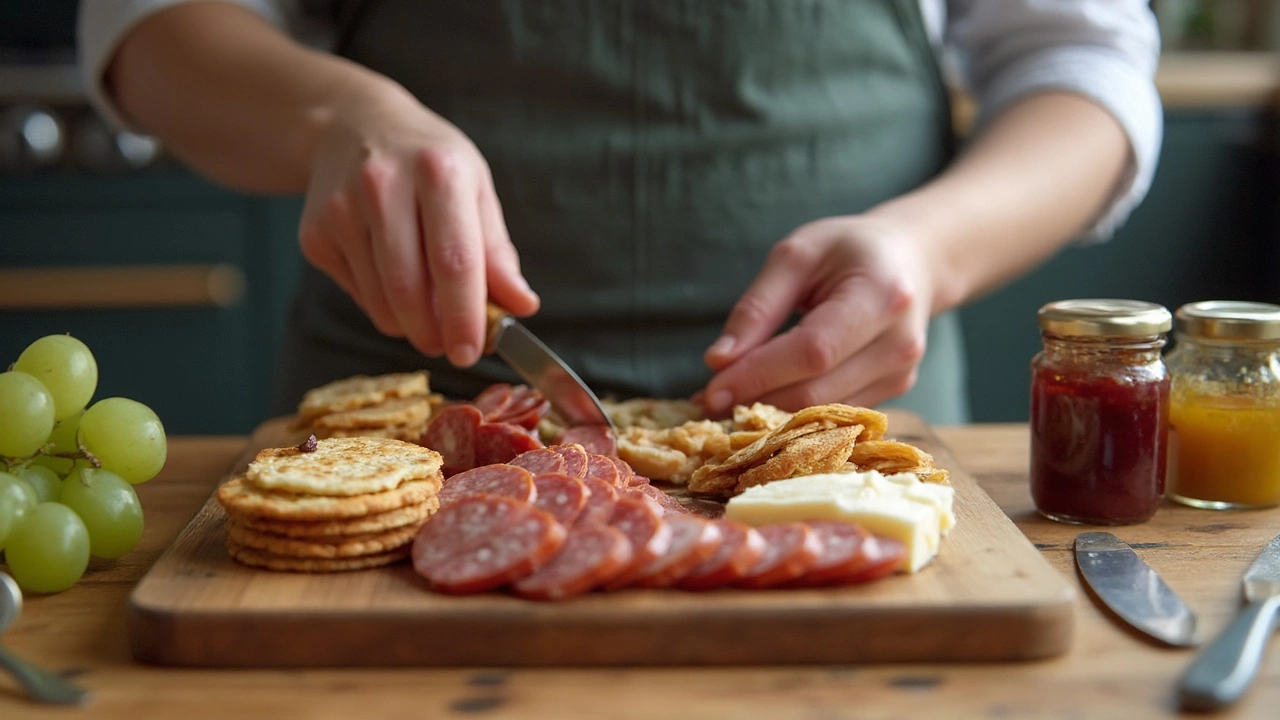Ever stood in front of a cheese counter totally lost? Been there. Building a charcuterie board can feel like a guessing game, but the 3-3-3 rule makes it way easier. Here's the deal: grab three kinds of cheese, three types of meat, and three extras—think crackers, nuts, or fruit. That's it. No math degree needed.
This isn't just some random trick. The 3-3-3 rule gives you enough variety to keep people interested, but not so much that your board turns into a confusing mess. Guests can pick and choose, mix flavors, and you'll look like the person who totally has their act together.
The cool thing? You’re not stuck with the same old stuff. You can swap options based on your crew’s favorites, what's in season, or which wine you already have. So, next time you’ve got folks coming over, save yourself the stress. With the 3-3-3 approach, your charcuterie board is pretty much guaranteed to hit the mark—no endless scrolling through recipe posts required.
- What is the 3-3-3 Rule?
- Picking Your Three Cheeses
- Matching Meats and Extras
- Wine Pairing Tips and Board Presentation
What is the 3-3-3 Rule?
The 3-3-3 rule is the simplest way to put together a crowd-pleasing charcuterie board without feeling overwhelmed at the store. All you do is pick three types of cheese, three types of cured meats, and three flavor-boosting extras. It covers all your bases for taste and texture, and keeps your board from looking crowded or chaotic.
This guideline didn’t come out of nowhere. Caterers and wine bars use similar ratios because they work, whether you’ve got four people or ten hungry guests. The balance helps people mix and match, but isn’t so much that anyone gets lost on what to try next.
- Three cheeses: Usually a mix of soft, semi-hard, and hard types. It’s a good way to cover all palates.
- Three meats: Think various textures: thin slices, spicy sticks, or hearty chunks. Salami, prosciutto, and chorizo are classics.
- Three extras: This is your chance to add color and crunch. Go for things like crackers, roasted nuts, dried or fresh fruit, even olives or pickles.
This approach has another big bonus: it saves you money. Wegmans reported in 2024 that shoppers who stick to a set plan like 3-3-3 spend 15% less than folks who freestyle and toss random stuff in their carts. So not only do you get better variety, your wallet gets a break too.
| Category | Purpose | Common Options |
|---|---|---|
| Cheeses | Texture & flavor variety | Brie, Cheddar, Manchego |
| Meats | Savory & spicy layers | Salami, Prosciutto, Coppa |
| Extras | Color, crunch, sweetness | Crackers, Grapes, Almonds |
Bottom line: the 3-3-3 rule keeps things simple and fun. You cover all texture and flavor zones, so nobody leaves the table thinking your board was boring. Plus, you’ll actually have time to enjoy the night, not spend it slicing cheese and fretting over missing olives.
Picking Your Three Cheeses
This is where your charcuterie board stands out. You want a lineup that hits different textures and flavors, so everyone finds something they like. Forget choosing at random—here’s how to build a cheese trio that works every time.
The smartest way is to grab one cheese from each of these groups:
- Soft: Think Brie, goat cheese, or fresh mozzarella. These bring a smooth, creamy bite and work great with crackers or fruit.
- Semi-Hard/Hard: Aged cheddar, Gouda, Manchego, or Parmigiano are solid picks. They add some serious flavor and a nice firm texture.
- Blue or Funky: Not everyone’s cup of tea, but a little blue cheese or something like a washed rind (Taleggio or Limburger) blows people’s minds. Even a sharp feta counts.
Sticking to this trio gives the board a good balance. You’ll cover mellow to bold flavors, and different milk types (cow, goat, sheep) if you mix it up right. If you’re really not sure what to choose, ask the cheesemonger. They usually love helping out and can suggest crowd-pleasers for every budget.
Here’s a quick cheat sheet comparing textures and popular options for each group:
| Type | Texture | Examples |
|---|---|---|
| Soft | Creamy, spreadable | Brie, Camembert, Fresh Goat Cheese |
| Semi-Hard/Hard | Firm, crumbly or sliceable | Aged Cheddar, Manchego, Gouda |
| Blue/Funky | Bold, tangy, sometimes creamy | Gorgonzola, Roquefort, Blue Stilton |
One tip: chop or slice your cheeses before guests arrive. No one wants to wrestle a giant wheel at the table. And don’t serve cheese straight from the fridge. Let it sit out about 30 minutes—this brings out the best flavor and texture. When it comes to charcuterie board building, these small moves actually make a huge difference.

Matching Meats and Extras
Now that the cheese part is sorted, let’s talk about the rest of your spread. With the 3-3-3 rule, you want three meats and three extras to balance out the board, give everyone options, and keep things from getting boring. If you’re after that classic European vibe, start simple and build from there.
When it comes to meat, don’t just grab whatever’s on sale. Grab a variety: something cured, something spicy, and something mild always works. Here’s a super common trio:
- Prosciutto – light, salty, and always impressive folded up or draped.
- Salami – go for Genoa if you want mild, or maybe a spicy Calabrese for some heat.
- Capicola or Soppressata – brings a smoky or rustic vibe, with decent fat marbling.
Here’s a pro tip: Buy pre-sliced meat from the deli counter if you don’t have time to fuss around at home. Prosciutto slices can stick together; use wax paper between them to keep things tidy and easy to grab.
Now for the extras—the little accessories that make your charcuterie board pop. Most people go for crackers, but that’s not your only option. Here are classic picks that show variety and give guests lots of flavor combos:
- Crunchy things: Crackers, breadsticks, or thin slices of baguette (toasted is even better).
- Sweet things: Grapes, dried apricots, or a little dish of fig jam. Fruit balances out all that saltiness and fat from the meat and cheese.
- Salty/savory things: Olives, marcona almonds, or pickles. Bonus points for something unexpected like cornichons or candied pecans.
If you like data, here’s a quick look at the most common charcuterie board picks in the US based on sales in 2024:
| Meat | Cheese | Extra |
|---|---|---|
| Salami | Sharp Cheddar | Crackers |
| Prosciutto | Brie | Grapes |
| Capicola | Manchego | Olives |
Remember, the charcuterie board doesn’t have to be fancy, but variety makes it feel special. Think color, texture, and flavor. Mix up spicy, salty, crunchy, and sweet and you’ll hit all the right notes with minimal effort.
Wine Pairing Tips and Board Presentation
Pairing wine with your charcuterie board shouldn’t feel like a chemistry test. Good news: you don’t need to memorize French vintages to get it right. The basic move? Match the intensity of the cheese and meat with the weight of the wine. Light wines go with milder cheeses and meats. Bolder wines go with the salty, stronger stuff. Simple as that.
- Softer, fresher cheeses (think brie or goat) love something crisp and acidic, like Sauvignon Blanc or even a sparkling wine. It kind of cuts through the creaminess and wakes up your taste buds.
- Sharp, hard cheeses like aged cheddar or Manchego don’t mind a little heat, so pour a glass of Cabernet Sauvignon or Malbec.
- Salty meats like prosciutto and salami have a thing with lighter reds, such as Pinot Noir, or even something bubbly like Prosecco for a fun twist.
- If folks are into blue cheese, try it with a sweet wine—think port or a Moscato. Sounds wild, but the balance is legit.
Want to make sure everyone feels included? Set out two or three wines: one white, one red, and maybe a sparkling if you’re feeling fancy. You don’t need dozens of bottles—just make it approachable.
| Cheese | Meat | Wine |
|---|---|---|
| Goat Cheese | Prosciutto | Sauvignon Blanc |
| Brie | Salami | Prosecco |
| Aged Cheddar | Speck | Malbec |
| Blue Cheese | Soppressata | Port |
Now, about that charcuterie board look. Start by spreading out your cheeses, then build everything else around them. Fold or roll the meats for extra style points, and fill gaps with colorful extras—grapes, nuts, whatever fits. If you’re using honey or jam, give it its own little dish, not just a blob on the wood. Toss in different colors and textures to keep eyes (and hands) moving across the board.
Aim for easy grabs. Nobody wants to wrestle with a sticky chunk of cheese while balancing a wine glass. Set out small knives and forks if things get messy. And don’t forget napkins—it always turns into a snack fest.


